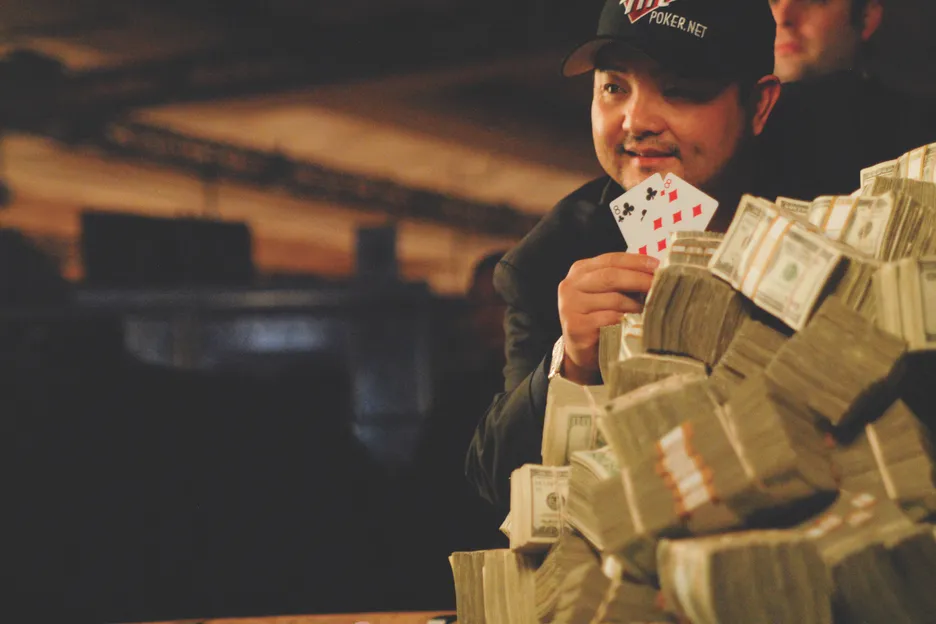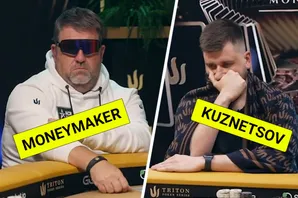When looking back at the history of poker’s biggest tournament series, from its birth in the 1970s, through its growth in the 1980s and 1990s and beyond, there’s no doubt that the 2000s was a transformative decade.
Arguably the three most significant developments in modern poker history took place within just a few years of each other, all around the turn of the century. The invention of online poker revolutionized access to convenient and regular poker games, the Unlawful Internet Gambling Enforcement Act (UIGEA) in turn restricted that access, and in between Chris Moneymaker’s WSOP win saw the popularity and visibility of poker explode at a global level.
Looking back at the story of the World Series of Poker in the 2000s, we can see the impact of these various events play out, as well as the rise of a new generation of poker superstars.
New faces for a new millennium
Online poker was around at the start of the new millennium, but not as we know it now. Real money online games began in 1998, but features we take for granted such as no-limit games, tournaments and satellites wouldn’t be widely available for some time.
And so the new faces making a splash at the 2000 WSOP were not the internet generation, but a roster of players who had come up the old-fashioned way: learning stud, playing limit games, grinding at local cardrooms and putting together their own strategy playbooks.
One such player who won his first bracelet in 2000 was Phil Ivey. In his first WSOP win Ivey beat that figurehead of the old guard, Amarillo Slim Preston, to the $2.5k PLO title. It would be Preston’s final WSOP final table appearance, but not Ivey’s.
Former champs like Huck Seed and Johnny Chan would pick up side event wins, but so too would the emblems of the new wave like Jennifer Harman, Howard Lederer and Chris Ferguson, all of whom picked up their first WSOP bracelets before the Main Event (ME) began.
Ferguson would go on to top the field of 512 in the ME, defeating TJ Cloutier heads up but also outlasting James McManus, who would go on to chronicle the experience in his book Positively Fifth Street. McManus’ sharing of his experience as an amateur competing for millions of dollars was a precursor to much of what was to come in the next few years.
2001 brought even more side events, with former champions including Scotty Nguyen, Phil Hellmuth, Berry Johnston and Chris Ferguson all proving they were no flukes and picking up wins. Erik Seidel beat Johnny Chan heads-up in the $3k NLHE event, getting revenge of sorts for his famous defeat in the ME 13 years earlier. Nani Dollison also won the Ladies’ event for the second year in a row, as well as winning a third bracelet in the $2k Limit Hold’em event.
Phil Hellmuth returned to the ME final table, finishing in fifth - one place above Mike Matusow and six ahead of Daniel Negreanu. Carlos Mortensen of Ecuador ended up winning the title and $1.5m, topping the field of 613 when he cracked Dewey Tomko’s pocket aces in the final hand of the tourney.
Boom time begins
You might notice in the clip above that the commentators didn’t know the players’ hole cards until they were flipped over. That changed in 2002 with the introduction of hole-card cameras - at least for the climax of the ME.
If Phil Ivey announced himself in 2000, 2002 was the year he really made his name on the WSOP stage, winning three bracelets playing Stud, Stud Hi/Lo and SHOE. Another side event winner was Allen Cunningham, who won the 2-7 Draw bracelet. Kevin from The Office must have gotten confused... for once.
The 2002 ME attracted bigger numbers again, with 631 ponying up the $10k to enter. When the final table was set, Phil Hellmuth was so sure that Robert Varkonyi wouldn’t win that he promised to shave his head if he did. The New Yorker did just that, picking up $2m for the win, while Hellmuth stayed true to his word and broke out the clippers.
2003 will always be the year that sticks out to any 21st century WSOP aficionado, though, marking the dawn of the Moneymaker Effect. The 839-strong field Chris Moneymaker defeated was the biggest yet, as was the $2.5m he collected for beating Sam Farha heads up, but it was his route to the WSOP itself that was perhaps the most influential part of the story. Winning his seat in an online satellite showed the world how far a hobbyist amateur could go in the game, and Moneymaker has continued to demonstrate how a passion for the game can translate into lasting success.
It may be a minor footnote to modern poker’s most iconic moment, but the story goes that Sam Farha only made it to the final table after Barry Greenstein persuaded him not to abandon his tiny stack after almost knocking Farha out on Day 2.
Could things have turned out differently had Farha not fought all the way back to that epic heads-up vs Moneymaker? With Farha out would Phil Ivey, who was eliminated just one spot short of the final table, have gone on to dominate the endgame and alter poker’s future? We’ll never know.
Population explosion
With Moneymaker having lit the fuse, 2004 saw interest in poker explode. More big names landed their first bracelets in side events, including Annie Duke, Kathy Liebert and Antonio Esfandiari, but the big news was over at the ME, where attendance rocketed. From 839 in 2003, there were now 2,576 players duking it out for the world title.
Many had won their way in thanks to online satellites, including the eventual winner Greg Raymer. The big money up top - the final five players all won at least $1m - did nothing to dampen enthusiasm, and so it was that the next year, in 2005, participation more than doubled to 5,619 entries.
Australia’s Joe Hachem took down that 2005 ME for $7.5m, with the entire final table banking million-dollar prizes. Mike Matusow was the only prior bracelet winner to make the final table, which was played for the last time at Binion’s Horseshoe, the original home of the WSOP. With the exception of the final few days of the ME, the series was held at the Rio. It may have moved on again, but it hasn’t returned to Binion’s since.
The 2006 event at the Rio was a high watermark for the WSOP for many years; the ME attracted 8,773 players and was won by Jamie Gold, playing a daring strategy employing speech-play and unrelenting aggression which landed him the bracelet and a huge $12m first prize.
The year also saw the inaugural $50k HORSE event, won by Chip Reese after a seven-hour heads-up duel with Andy Bloch. The tourney eventually morphed into the $50k Poker Players Championship in 2010, with the trophy still bearing Reese’s name as a tribute to the poker great who passed away in 2007.
Checked progress
Could the WSOP continue its exponential growth in 2007? The answer was no, but not because of any waning of poker’s appeal.
The Unlawful Internet Gaming Enforcement Act (UIGEA) of 2006 had numerous effects, but one in particular made an impact on numbers in the ME, which attracted ‘only’ 6,348: poker sites could no longer award WSOP packages to players in the USA.
Thus the eventual ME winner, Jerry Yang, had won his seat in a traditional ‘brick & mortar’ satellite. Yang entered the final table as a short stack but went on a tear, knocking out seven of his eight opponents on his way to the $8.25m first prize.
And despite the drop in attendance for the ME - the first in many years - the series featured another record-breaking tourney at the $1.5k buy-in level. 3,151 players took part in a NLHE side event, the biggest ever live poker tournament outside the WSOP ME, which was won by Chandrasekhar Billavara.
Young guns, and younger guns
2008 saw more new faces register their first wins, with the likes of Phil Galfond, Vanessa Selbst and Scott Seiver picking up bracelets. The older guard did well too, with Negreanu, Matusow and Greenstein winning side events, and 1998 champion Scotty Nguyen taking down the prestigious $50k HORSE.
At the ME there were 6,844 runners, an increase on 2007 but some distance from the numbers seen in 2006. Peter Eastgate won it for $9.1m, but he would have to wait many months to do so. For the first time, the concept of the ‘November Nine’ was introduced, with ME play halting when the final table was reached, and resuming in November to make the most of TV coverage.
Eastgate emerged victorious and was the youngest-ever ME champion at 22, beating the record Hellmuth set in 1989 (24). If the ME had played out as usual, he’d have won it at an even younger age.
Jason Mercier was one of those recording his first bracelet win in 2009, a year in which Jeff Lisandro achieved the feat of winning three side events in three different variants of Stud (7-Card Stud, Stud Hi/Lo and Razz), winning the Player of the Year contest in the process.
Phil Ivey won two side events before making his deepest run to date in the ME, finishing in seventh place. Ivey was the only player at the FT with a bracelet to his name, but couldn’t close it out. At least he was able to play, though: the 6,494 entries in the ME did not include Patrik Antonius, Layne Flack, TJ Cloutier or Ted Forrest, all of whom are believed to have been turned away as the venue reached capacity.
The 2009 winner, Joe Cada, once again had to wait until November to finish off the ME, picking up a PokerStars sponsorship in the intervening months. Cada, at 21, broke Eastgate’s recent record as the youngest ever ME winner, but he was in fact already a fairly well established pro. He’d been backed for the WSOP and so split his $8.5m prize with his backers.
And so ended a tumultuous decade in the history of the World Series of Poker. It was a decade that began with victory for Chris Ferguson, a thirty-something computer scientist in a field of 512. It ended with a win for Joe Cada, a kid barely old enough to legally play in a casino, but already with backers, a sponsorship deal and a field of over 6,000 players to navigate.
Since the start of the new millennium everything seemed to have changed, from the WSOP schedule, to the type of players competing, to the entire world outside the casino doors. The only thing anyone could be sure of was that, when it came to the WSOP, anything could happen.
Next time: the 2010s





































